The Rakow Library holds many rare and archival materials, and we are continually challenged to improve access to these materials while preserving them for future generations.
Recently we had a visit from Steven Galbraith, Curator of the Melbert B. Cary, Jr. Graphic Arts Collection at Rochester Institute of Technology (RIT) and former Andrew W. Mellon Curator of Books at the Folger Shakespeare Library. He visited the Library to discuss the handling, preservation, and conservation of rare books and archival materials.
Library staff pulled some of their favorite rare books from the stacks for discussion, as well as items that present challenges with handling and care. Galbraith was particularly interested in our 1492 edition of Bartholomeus Anglicus’ De proprietatibus rerum (“On the Properties of Things”) (see the fully-digitized text). This book has been through over 500 years of history, including the 1972 flood. After the flood, preservation expert Carolyn Horton removed the original binding and replicated it in a new leather binding, preserving what was left of the original binding in Mylar for comparison and scholarly use. Galbraith admired the preservation binding and original brass fittings, and speculated that while the book was printed in Nuremburg, the paper was likely made in France (as was common in the period). He was even more excited to find evidence of bookworms in the pages and the original cover (which he speculated was made of pig skin).
- Preservation cover with original brass fittings for Bartholomeus Anglicus’s De proprietatibus rerum.
- The small, round holes on this page are evidence of bookworms.
Galbraith spoke about the preservation and conservation issues that come with any book—torn pages, broken bindings, shoddy repairs—and how to balance preservation with access to library users. The staff asked many questions about handling techniques and experimented with different forms of support for everything from pocket-sized batch books to large posters and trade catalogs. In general, rare and fragile books need extra support, so using foam book supports and “snakes” (weighted strings and pouches – seen in the photograph of the Mappae clavicula) helps keep the book in a safe, stable position, while also allowing the researcher to examine the book and take notes. White gloves, while sometimes associated with rare books, are actually more harmful to fragile pages than any oils on your fingers. Researchers wearing cotton gloves are more likely to tear a page or transfer residue between books than those who have washed their hands before using a book. White gloves are recommended when handling film or photographic paper—in this case the benefits outweigh any drawbacks.
- Galbraith and staff members examine a rare book.
- The 12th century Mappae clavicula.
- Staff members decide which foam supports to use.
- Staff looks through some of their favorite rare books.
- Galbraith talks about preservation concerns like book spine damage.
Galbraith and the staff also discussed best practices for displaying books in exhibitions. The Rakow Library has its own exhibit space and whenever possible uses original materials from the collection in its exhibitions. Books, photographs, documents, and other library materials are light and temperature sensitive, and can only be on display for a certain amount of time. Galbraith discussed his exhibitions and tips for displaying materials without damaging them.
We would like to thank Steven Galbraith for visiting and sharing his extensive knowledge of rare books and special collections with the staff of the Rakow Library.
Browse Library collections, including our special collections and archives.
The Rakow Research Library is open to the public 9am to 5pm every day. We encourage everyone to explore our collections in person or online. If you have questions or need help with your research, please use our Ask a Glass Question service.


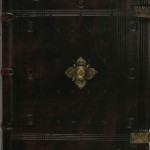
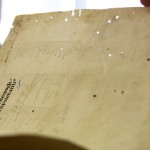
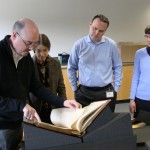
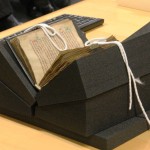

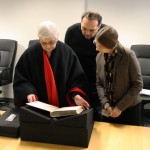
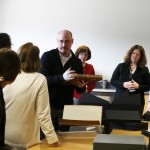
1 comment » Write a comment